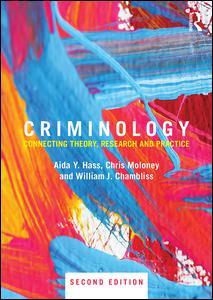Criminology (2nd Ed.) Connecting Theory, Research and Practice
Auteurs : Hass Aida, Moloney Chris, Chambliss William

Connections among theory, research, and practice are the heart and soul of criminology. This book offers a comprehensive and balanced introduction to criminology, demonstrating the value of understanding the relationships between criminological theory, research, and practice in the study of crime and criminal behavior. Utilising a range of case studies and thought-provoking features, it encourages students to think critically and provides a foundation for understanding criminology as a systematic, theoretically grounded science. It includes:
- A comprehensive overview of crime in American society, including the nature and meaning of crime and American criminal law as well as the scientific study of crime,
- A concise, straightforward, and practical approach to the study of the American criminal justice system and its various components, including individual chapters on police, courts, and corrections,
- An overview of criminological theory, including classical, biological, psychological and sociological approaches,
- A survey of typologies of criminological behavior including interpersonal violent crimes, property crime, public order crime, organized and white collar crime, state crime, environmental harm and cybercrime,
- Concluding thoughts exploring challenges facing criminal justice policy and the future of criminological theory.
This new edition has been thoroughly revised and updated and includes brand new chapters on corrections, courts, criminal law, law enforcement, and technology and cybercrime. It is packed with useful and instructive features such as themed boxed case studies in every chapter, critical thinking questions, lists of further reading, and links to e-resources. A companion website includes PowerPoint slides for lecturers, links to useful resources, and lists of further reading.
Preface
How to use this book
PART I: CRIME, CRIMINAL LAW AND CRIMINOLOGY
1. Crime, Deviance and Criminology: A Brief Overview
2. Criminal Law
3. How Much Crime is There?
4. Doing Criminology: Research and Theory
PART II: THE CRIMINAL JUSTICE SYSTEM IN ACTION
5. Connecting Criminology and Criminal Justice
6. Law Enforcement in America
7. Courts
8. American Corrections
PART III: AN OVERVIEW OF CRIMINOLOGICAL THEORY
9. Crime as Rational Behavior: Classical and Rational Choice Theory
10. Biological Theories: Crime is in the Brain
11. Psychological Theories: Crime is in the Mind
12. Sociological Theory: Crime is in the Structure of Society
13. Sociological Theory: Crime is Socialized Behavior
14. Sociological Theory: Crime is in Conflict Inherent to Society
PART IV: TYPOLOGIES OF CRIMINAL BEHAVIOR
15. Interpersonal Crimes of Violence
16. Crimes against Property
17. Public Order Crimes
18. Crimes of the Powerful
19. Green Criminology and Environmental Harms
20. Technology and Cybercrime
PART V: A LOOK AHEAD
21. Crime Today, Crime Tomorrow – The Future of Criminological Theory
Aida Y. Hass is an Associate Professor of Criminology and Criminal Justice at Missouri State University.
Chris Moloney is the Criminal Justice Study Abroad Program Director and an Instructor of Criminal Justice at the American Center for Study Abroad at Sichuan University in Chengdu, China.
William J. Chambliss (1933-2014) was Professor of Sociology at George Washington University.
Date de parution : 12-2016
17.4x24.6 cm
Date de parution : 12-2016
17.4x24.6 cm
Thème de Criminology :
Mots-clés :
Press Association Images; Criminal Behavior; Cybercrime; Crime Trends; Routine Activities Theory; Crime Data; Motor Vehicle Theft; Criminal Justice System; Cyber Crimes; Corrections; White Collar Crime; Criminological Theory; Comparative Criminology; Crime Typologies; Young Man; Organized Criminal Groups; Antisocial Behavior; Malice Aforethought; Rational Choice Theory; National Crime Victimization Survey; American Criminal Justice System; Ta Ge; Green Criminology; Rational Choice; Vis; Social Process Theories; Peacemaking Criminology; Pre-Sentence Investigative Report; PreSentence Investigative Report; Insanity Defense; Jury Nullification



